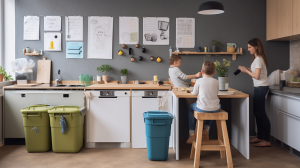Understanding the Importance of Reduce, Reuse, and Recycle
Understanding the importance of reducing, reusing, and recycling is fundamental in our quest for a more sustainable lifestyle. The “Three Rs” or “3Rs,” as they’re often referred to, emphasize the need to take conscious steps to minimize the amount of waste we generate. These actions establish a palpable way to reduce the mounting pressures on our natural resources. By strategically reducing the consumption of products or materials such as plastic, we could significantly lessen the volume of waste heading to our landfills and recycling centers. Moreover, if we properly dispose of items in appropriate recycling bins or adopt appropriate waste management systems, we could repurpose various products, leading to a substantial reduction in the need for new materials to be extracted from the earth.
An easy and recommended habit of recycling that everyone can start is segregating waste into appropriate bins such as a recycling container for plastic, paper, and cardboard, and a compost bin for organic waste such as food scraps and coffee grounds. It’s also advisable to reduce the amount of waste you create by making a conscious decision to purchase products made from recycled materials or items that use less packaging. Instances of these include shopping bags made from recycled paper or reusable water bottles instead of using plastic disposable items.
Additionally, we can achieve substantial savings, both environmentally and financially, by reusing items like cloth napkins, coffee mugs, and grocery bags instead of throwing them away after single use. By practicing proper recycling, making a conscious effort to reduce and reuse, and even improving our recycling habits such as curbside drop-off for particular items or visiting the local recycling center, we can make significant strides in waste reduction, conserving our natural resources, and protecting the environment.
Ways to Reduce: Tips on Trimming the Amount of Waste You Create
 In the quest for living a more sustainable lifestyle, one crucial step is to reduce waste as much as possible. You may not notice it, but the amount of waste you generate contributes significantly to overall waste generation. Devoting time and effort to trimming back on this can lead to enormous benefits, not just for the U.S. but globally.
In the quest for living a more sustainable lifestyle, one crucial step is to reduce waste as much as possible. You may not notice it, but the amount of waste you generate contributes significantly to overall waste generation. Devoting time and effort to trimming back on this can lead to enormous benefits, not just for the U.S. but globally.
Furthermore, it saves money in the long run, and it’s healthier for both the environment and you. If you’re looking to achieve this, here are 7 tips to get you started. Firstly, make recycling easy in your home or workspace, ensure there’s a recycling program in place and everyone is educated on how to recycle correctly. A well-structured program will improve your recycling habits, turning even the most reluctant person into an enthusiastic recycler. Secondly, reduce the use of plastic, particularly plastic bags, and opt for alternatives like paper or cloth bags.
Reducing waste doesn’t merely involve what we don’t throw away; we can also apply this in how we manage waste. For instance, instead of throwing away used materials, repurpose or upcycle them into something new. Another potent idea is to turn organic waste into compost, a practice that considerably lessens the volume of municipal solid waste being taken to landfills. Opt for recyclable materials like glass and metal instead of disposable plastic containers. On the note of disposables, consider sustainable alternatives such as cloth diapers instead of disposable diapers.
There are many other ways to lessen waste generation that only need a little creativity and ingenuity. Avoiding hazardous waste by choosing safe alternatives can save money and also pollute the environment less. The principle of “buying new” can be reevaluated, too – consider buying recycled products or even used items. Through these initiatives, we can all benefit from the rewards of recycling services, and not only lessen the volume of trash ending up in landfills but also reduce the quantity of raw materials extracted from the earth.
How to Correctly Recycle your Waste: From Pizza Boxes to Plastic
Correct recycling of waste materials, from pizza boxes to plastic, not only contributes to environmental conservation but also promotes sustainable living. Many of us want to recycle but are sometimes unsure of how to make it happen correctly or efficiently. The first step to doing this more successfully involves developing an understanding of the benefits of recycling, and identifying what materials are recyclable. Many everyday items such as plastic bottles, paper products, and even pizza boxes can be reused in some way. However, it’s important to note that not all materials can be recycled in the same manner. For instance, pizza boxes, a popular item of confusion, should be grease-free to be recycled otherwise the oil can contaminate other recyclable items.
Before you start recycling, determine which items in your trash can actually be recycled, and remember the rule: when in doubt, throw it out. Don’t throw everything in the recycle bin thinking that it will all be sorted out later, as this often leads to ‘contaminated’ recyclables that mostly end up as dismissed. To recycle better, take into account the following points:
- Always remove any non-recyclable components, such as plastic lids or window envelopes.
- Don’t recycle food-contaminated items, even if they are usually recyclable (like pizza boxes).
- Try to switch from using plastic bags to reusable ones to reduce plastic pollution.
- If possible, rinse your recyclables before placing them in the bin, this can significantly improve the recycling process.
The handling of plastic waste is particularly essential, considering the significant threat plastic pollution poses to our environment. Furthermore, the emphasis should be on reducing gas emissions, a product of landfill waste, by recycling and composting organic waste where possible. Remember, once the choice is made to recycle, you’re more likely to continue with this practice, creating a lasting positive impact on our planet.
The Danger of Wish Cycling and Proper Waste Management
 The prevailing concept of “Wish Cycling” poses a significant risk to proper waste management.
The prevailing concept of “Wish Cycling” poses a significant risk to proper waste management.
This dangerous practice, often performed by individuals who are likely to recycle, involves depositing non-recyclable items into the recycling bin with the hopeful thought that they can somehow be recycled.
While the intention may seem noble, it often leads to contamination, causing difficulties for waste sorting facilities and creating more harm than good. Therefore, understanding the difference between what can and cannot be recycled is critical to steering clear of wish cycling.
To achieve this, we can follow some simple rules. For example, as a rule of thumb:
- Paper, plastic containers (types 1 and 2), glass bottles, and metal cans are generally recyclable.
- Items like batteries, light bulbs, foam material, and plastic bags are typically not suited for regular recycling.
In addition, packaging layered with different materials or food-soaked items are not ideal for recycling as well. Ensuring proper waste management isn’t just about recycling, knowing what goes into the trash is another pivotal aspect. Remember, the goal is to recycle right, not just recycle more. By doing so, we can make more meaningful strides in our journey towards sustainable living.
Additional Resources You Might Also Like on the Cycle of Reduce, Reuse, and Recycle
There are several valuable resources you may want to explore to gain more comprehensive knowledge about the cycle of reducing, reusing, and recycling. These resources provide a broad range of perspectives and data, serving to raise awareness about the essentiality of these practices and encouraging people who are likely to recycle. Whether you need educational materials, practical tools, or avenues for engagement, these resources have you covered.
For instance, the Environmental Protection Agency’s extensive guide on the 3 R’s cycle provides an in-depth look into the practical ways of implementing this cycle for both individuals and businesses. Moreover, websites like Waste360 and Trash is Another’s Treasure offer articles and blog posts on relevant topics, as well as links to interesting research studies. Other resources you might find useful include:
- GreenEducationFoundation.org: Offers lesson plans and activities to educate youth about waste management and the importance of reducing, reusing, and recycling.
- Earth911.com: A gateway to recycling centers and green living tips.
- Freecycle.org: An online network that encourages waste reduction by connecting people who have items they no longer need with people who can reuse them.
Choosing to delve into these additional resources not only supplements your knowledge base but also inspires actionable steps toward a more sustainable lifestyle. By utilizing these platforms, individuals can become more informed about the impact of their daily choices and discover new ways to contribute positively to environmental conservation. Ultimately, exploring these resources is a step towards embracing a lifestyle that prioritizes the health of our planet.
Conclusion
In conclusion, the contemporary global scenario paints a vivid picture where a shift towards sustainable practices is imminent. The understanding of how our actions significantly affect the environment is becoming increasingly widespread. Several individuals and organizations are ‘likely to recycle’ and reduce waste, embracing recycling programs with enthusiasm as they recognize it’s a potent solution to our burgeoning waste problem.
Furthermore, societies are starting to view waste differently, adopting the mantra that ‘trash is another’ resource. This means treating trash not as waste, but as a valuable commodity that could be repurposed or recycled into new products. This perspective shift could result in a notable reduction in waste sent to landfills and improved recycling rates.
By employing these methods, it is hoped we would reduce our environmental footprint, conserve natural resources, and promote a circular economy where products are used, recycled, and then re-introduced into the supply chain. If we all play our parts, the likelihood of a sustainable future is more promising. Thus, the power to make a difference lies with every individual.
FAQ’s:
Q1. How can I make recycling a habit?
A1. Making recycling a habit is likely to reduce the amount of trash that ends up in landfills. To make recycling a habit, start by setting up a recycling bin in your home and making sure to use it for all recyclable items.
Q2. What are the benefits of recycling?
A2. Recycling helps to reduce the amount of waste that ends up in landfills, conserve natural resources, and reduce the amount of energy used to create new products.
Q3. What are some tips for recycling?
A3. Some tips for recycling include sorting your recyclables, cleaning and drying them before recycling, and avoiding mixing recyclables with trash.
Q4. What items can be recycled?
A4. Many items can be recycled, including paper, cardboard, plastic, glass, and metal.
Q5. What is the best way to recycle?
A5. The best way to recycle is to sort your recyclables, clean and dry them before recycling, and avoid mixing recyclables with trash.
Q6. How can I encourage others to recycle?
A6. You can encourage others to recycle by setting a good example and educating them on the benefits of recycling.
Q7. What is the difference between recycling and reusing?
A7. Recycling involves breaking down materials into their raw components and using them to create new products, while reusing involves using an item multiple times without breaking it down.

Aleksandra Kosanovic
Aleksandra Kosanovic is a dedicated advocate for sustainable living, committed to empowering individuals to make eco-conscious choices. With a background in environmental activism, Aleksandra shares practical tips and innovative solutions for a more sustainable lifestyle. Join her in the journey towards a planet-friendly future.


 Recycling 101 | A Comprehensive Guide To Sustainable Waste Management
Recycling 101 | A Comprehensive Guide To Sustainable Waste Management
